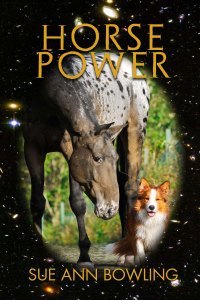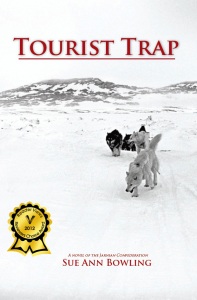 This set of two DVDs, although the cover has a date of 2008, in fact combines episodes originally aired on the Discovery Channel from 2001 to 2008. The first disc contains four episodes: Valley of the T. Rex (2001), T-Rex: New Science, New Beast (2006), When Dinosaurs Roamed America (2001) and Utah’s Dino Graveyard (2005). Keep the true dates straight, because our interpretation of dinosaurs is changing rapidly, and the episodes at times seem to contradict each other. None of the interpretations are truly currant, or represent today’s ongoing controversies.
This set of two DVDs, although the cover has a date of 2008, in fact combines episodes originally aired on the Discovery Channel from 2001 to 2008. The first disc contains four episodes: Valley of the T. Rex (2001), T-Rex: New Science, New Beast (2006), When Dinosaurs Roamed America (2001) and Utah’s Dino Graveyard (2005). Keep the true dates straight, because our interpretation of dinosaurs is changing rapidly, and the episodes at times seem to contradict each other. None of the interpretations are truly currant, or represent today’s ongoing controversies.
This DVD focuses on the processes of finding, unearthing and interpreting fossils, with only minor clips of computer generation of the living animals. It will be of more interest to budding paleontologists than to those looking for entertainment.
Valley of the T-Rex looks at the idea put forward by Jack Horner that T-Rex was primarily a scavenger, not a predator. The idea is hardly new, and is far earlier than the discovery of T-Rex’s tiny arms – Wiley Ley proposed it as a science article in the April 1943 issue of Astounding Science Fiction. I really doubt that there is any such thing as a pure predator or a pure scavenger. Any predator will scavenge a fresh kill, and any scavenger will kill an animal down and helpless, if only by eating it. Like the short-faced bear, T-Rex may have used its impressive size to intimidate other predators off their kills, but that doesn’t mean it never killed.
T-Rex: New Science, New Beast is more balanced, mentioning that how T-Rex fed is controversial but not getting into the controversy. Rather, it summarized new (as of 2006) methods of investigating dinosaur fossils. This included learning how to tell how old fossil dinosaurs were at death (which led to the discovery of the fantastic teenaged growth spurt of T-Rex and the relatively young age (29) of Sue, the largest T-Rex found.) At least one dinosaur was sexed, though the technique only works with pregnant (with eggs) females. Study of locomotion in modern animals has been applied to dinosaur skeletons, suggesting a lower top speed for full-grown T-Rex than was previously estimated. The episode also mentioned the discovery that some fossil bone had collagen, study of T-Rex bite strength, and the discovery of feathered theropods, leading to the possibility that T-Rex juveniles, at least, had downy feathers.
When Dinosaurs Roamed America goes through the history of dinosaurs, using an American location to spotlight each time period. Remember this segment, and the computer animated clips included, is eleven years old in 2012.
The video starts with New York (Permian-Jurassic, first dinosaurs, early opening of the Atlantic.) It then moves on to Exeter Township, PA (Triassic-Jurassic boundary, theropod-sauropod split.) Utah was a savannah 150 million years ago, wandered over by giant sauropods, their predators, and the smaller herbivorous dinosaurs that survived at their side. New Mexico 90 million years ago was a tropical swamp, with an explosion of flowering plants and broadleafed trees. The notorious K-T (Cretaceous-Triassic) boundary and the final extinction of the dinosaurs is investigated in South Dakota. The video is not bad, but dated.
The final program, Utah’s Dino Graveyard, covers a single location with a huge number of dinosaur fossils of a single species. Falcarius Utahensis was a strange beast even by dinosaur standards, as are most of its Therizinosaurian relatives. It is one of the earliest of a group that evolved from raptor-like carnivores to big-bellied but still relatively upright herbivores. This does happen – all dinosaurs, even the huge sauropods such as Apatosaurus evolved from early ancestors that ran on two legs and preyed on insects. More recently, the giant panda seems to be a bear that has embraced a diet of bamboo.
The real question is, what killed large numbers of the same species? Their preservation seems to be due to the fact that they all died near ancient springs, with rock from the spring deposits forming a cap that preserved their bones, but could the spring also have played a role in their deaths?
In general the computer graphics are adequate but not inspired, and at times show behavior I have doubts about — but I’ll save that critique for the second disc.
 In the spring of 2007 Yuri Khudi, a reindeer herder in northwestern Siberia, found a baby mammoth carcass, still frozen and remarkably complete, lying on the snowy tundra. Scientists named her Lyuba (little love) after Yuri’s wife – who did not appreciate the honor! Lyuba’s discovery and the scientific investigation that followed became the subject of a National Geographic program, first aired roughly two years after her discovery, and later made available as a DVD.
In the spring of 2007 Yuri Khudi, a reindeer herder in northwestern Siberia, found a baby mammoth carcass, still frozen and remarkably complete, lying on the snowy tundra. Scientists named her Lyuba (little love) after Yuri’s wife – who did not appreciate the honor! Lyuba’s discovery and the scientific investigation that followed became the subject of a National Geographic program, first aired roughly two years after her discovery, and later made available as a DVD.














 Buy Homecoming from iUniverse
Buy Homecoming from iUniverse















